Victoria not victorious in RTW

Watching the landscape of return to work over time, the ebb and flow in the standards of performance within jurisdictions appears to follow something like a natural rhythm. Down works its way up, until up gets lost and falls back down again.
WorkSafe (nee WorkCover) Victoria turned its negative financial performance around over the last decade. Much of this was achieved via tight management of long term expensive claims. This in conjunction with good return on investments from the funds held through WorkCover premium collections turned around Victoria from basket case to suggestions of ‘leading light’.
Fine financial results. Yet the socially responsible aspect of the workers compensation response to people who have had an injury resides in how individuals are dealt with in the early stages of their claim. Stopping someone’s payments after a few years doesn't mean their health will improve, and it doesn't mean they will get back to work. Once a person is in a pattern of long term disability they are likely to remain there. They often move on to another system, incapacity benefits through their super fund, or perhaps a disability pension.
A system that doesn’t deal with disability early increases the likelihood of long term health and social problems; inactivity, depression, heart problems, lung cancer, increased mortality, marriage breakdown, increased health problems in the children of those who remain out of work. This is the opposite of Work Health.
In 2006 WorkSafe Victoria established a Return to Work Division with the following objective: 'Over the next 5 years the Return to Work Division will become a recognised centre of excellence in RTW management across Australia.' We applaud the stated commitment, and that WorkSafe has publishes their performance against targets.
How have WorkSafe Victoria gone? According to the annual RTW Monitor Report published by the Heads of Workers Compensation Authorities Australia and New Zealand, return to work outcomes in Victoria have declined in each of the last three years.
Not satisfied with the RTW Monitor methodology WorkSafe Victoria is rumoured to be about to withdraw from this annual summary. This would be unfortunate, causing a glaze on an already dim national transparency. In place of it Victoria will use its own annual survey of 4,000 claimants. We ask WorkSafe to make public the range of measures of return to work and the results of questions in their survey.
While a range of initiatives have been put in place within WorkSafe Victoria to improve RTW outcomes, the results from the Australia New Zealand RTW Monitor show that return to work performance in Victoria has been declining for the last three years.
The financial downturn is said to have had an impact on return to work rates, yet neighbouring states Tas and SA, facing the same societal and economic conditions, have improved their RTW performance, indeed, Tasmania consistently outperformed the national average. Further, the decline in Victoria's performance pre dates the financial downturn.
Durable return to work, a measure of sustained return to work, has declined from 77% to 69% in Victoria over the last three years. Data we have extracted from the RTW Monitor shows the average number of days off work for each claim in Victoria is increasing, from 53 in 2005-06 to 66 in 2007-08. There is a corresponding increase in claims costs.
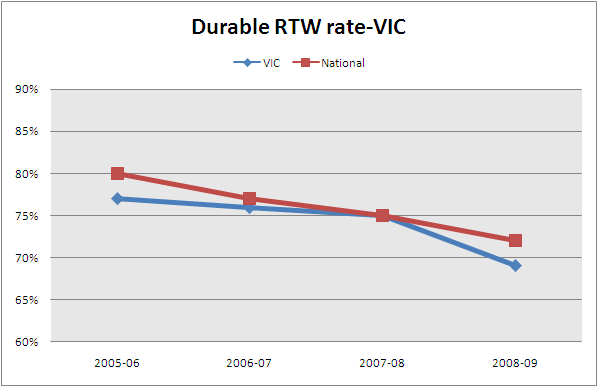 |
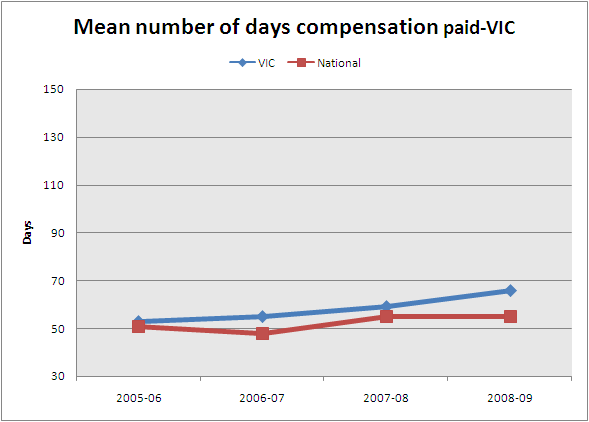 |
Why are results declining?
Most people return to work without difficulty; they want to be at work and their employer wants them back. Things go smoothly.
Yet in less straightforward cases a wealth of research shows that the texture of the approach taken by those involved has a major impact on the outcome. Analysis of the RTW Monitor data shows a strong correlation between the quality of the approach of the employer and return to work of the employee.
In Victoria the quality of approach by employers and insurers (claims agents) to claimants is under par and in decline.
RTW plans are required for many claims. About 55% of Victorian employees indicate a RTW plan was developed for their return to work. The proportion of employees who say their plan is helpful has gone down over the last three years. In the 2008-09 year only 30% of employees with an injury indicated a return to work plan was developed AND they were given assistance to follow the plan.
The proportion of employees who say their employer is making return to work harder has increased significantly.
Less than 40% of employees who have had a claim say the insurer / claims agent helped their return to work. The proportion who declare the insurer / claims agent made return to work harder has increased by 75% over the last two years. Victoria's claims approach has consistently rated below the national average.
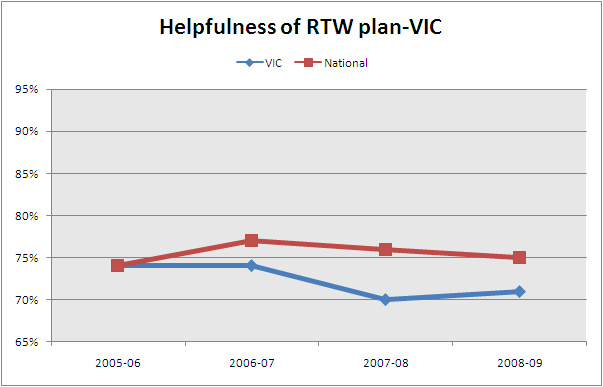 |
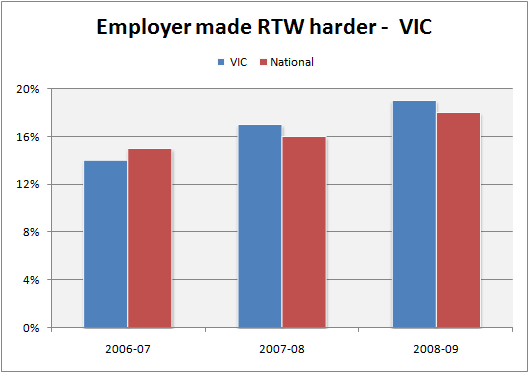 |
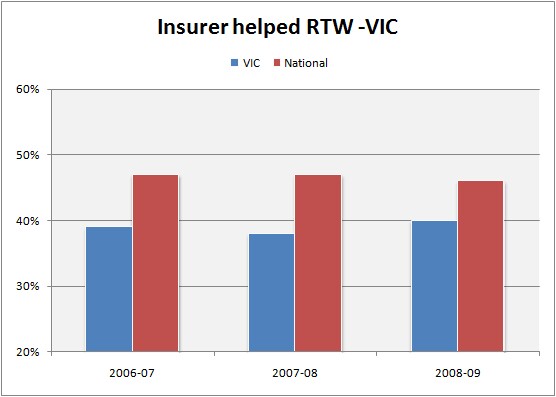 |
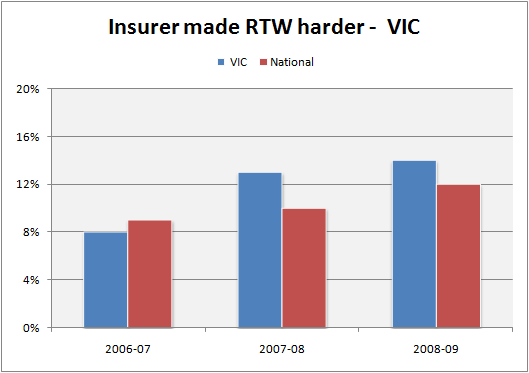 |
In our experience an authority can regulate the life out of claims and stipulate what claims managers and employers must do, but that does not improve return to work.
Return to work is about people. The principles behind success do not reside in filling out forms, satisfying processes for an audit, telling an employer they must do this or that.
Process is necessary, but partnership is far more important. Working WITH people to create a constructive relationship between the employee and their supervisor, fostering communication, helping claimants get the medical care they need. When claims staff within a jurisdiction report that they don't have time to talk to claimants because they have so many processes to follow, something is astray.
The recurrent complaint we hear from the field about WorkSafe Vic is that it is authoritarian and process driven.
The principles of return to work (accommodation, accountability, agreed outcomes, communication, empathy / respect, leadership, shared decision making, speed, trust) are not easy for a bureaucracy to embrace and embed in their approach. Do the Board, the senior management team, the organisation as a whole understand these principles? Does the Minister understand the principles of return to work? Does the Authority review the above measures and discuss the implications? Do they listen to what happens to employees, do they hear the day to day barriers employees experience with return to work?
Or is the system in Victoria comfortable with a situation that appears politically acceptable, has comparatively low premium rates and funded liabilities, yet operates at the expense of the employees whom the system is designed to assist?
Our analysis of the various jurisdictional results from the RTW Monitor has sought to highlight trends and comparison between the jurisdictions. The vertical scales of graphs have been adjusted to highlight changes and differences. The scales used are constant across each question, to allow for ease of comparison.)

